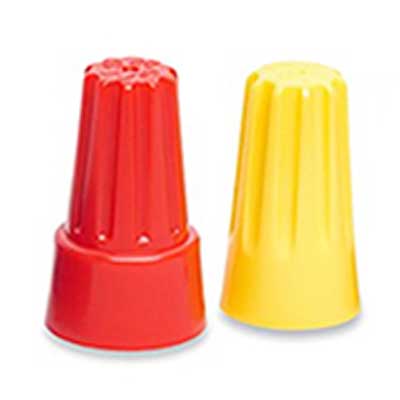
| Part Number | Model | Dimension (mm) | Color | |||
|---|---|---|---|---|---|---|
| Min | Max | W | C | L | ||
| SCTSP1141 | 0.75×1+0.5×1 | 1.5×2 | 8.5 | 6.7 | 15 | Gray |
| SCTSP2141 | 0.75×3 | 1.5×3 | 10.1 | 7.4 | 17.5 | Blue |
| SCTSP3141 | 0.75×3 | 1.5×3+1×1 | 12.6 | 9.9 | 22.1 | Orange |
| SCTSP4141 | 0.25×1+0.75×1 | 2.5×4+0.75×1 | 13.7 | 11 | 24.5 | Yellow |
| SCTSP6141 | 0.25×2 | 6×2+4×2 | 16 | 13 | 26.5 | Red |
Understanding Wire Nuts: Functions, Applications, and Safety Precautions
In electrical installations and repairs, wire nuts are common tools used for safely connecting electrical wires. This article will introduce the functions, applications, and safety precautions when using twist-on connectors.
1. What are Wire Nuts?
Wire nuts are small tools typically made of thermoplastic outer shells with inner metal coils or threads. They are used to connect two or more wires securely, ensuring reliable circuit connections and safe operation. Twist-on connectors come in various shapes and sizes, depending on the number and gauge of wires to be connected.
2. Functions and Applications
– Secure Connection: Twist-on connectors create a mechanical connection by twisting the wires together, ensuring a secure bond. This connection helps prevent wires from loosening or coming apart, reducing the risk of fire hazards and electric shocks.
– Insulation Protection: Wire nuts often include insulation materials, effectively preventing direct contact between wires and providing additional insulation protection. This is crucial for preventing short circuits and circuit failures.
– Wide Range of Applications: Twist-on connectors are suitable for various types of electrical connections, including residential, commercial, and industrial applications. Whether installing new circuits or repairing existing ones, they are valuable tools in electrical work.
3. Safety Precautions
– Selecting the Correct Size: Choosing the right size wire nut is essential. It should accommodate the number and gauge of wires to be connected to ensure a safe connection.
– Proper Connection Method: When using wire nuts, always follow the correct procedure for connecting wires. Typically, this involves inserting the wire ends into the wire nut and twisting clockwise until securely connected.
– Inspecting Connection Quality: After every wire connection, inspect the quality of the connection. Ensure the wires are securely joined and show no signs of loosening or detachment.
– Following Safety Standards: When performing electrical work, always adhere to applicable safety standards and regulations. This includes using tools correctly, wearing appropriate personal protective equipment, and seeking professional assistance when necessary.
Conclusion
Wire nuts are indispensable tools in electrical work, ensuring the safety and reliability of circuit connections. Proper selection and use of wire nuts can help reduce circuit failures and accidents, safeguarding both personnel and equipment. Therefore, always use twist-on connectors correctly and follow safety procedures when performing any electrical work.